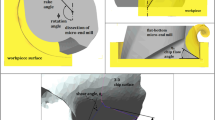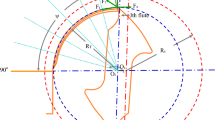Abstract
Finite element simulations have been utilized in analyses of machining process for several decades. In mechanical micromachining, finite element simulation can also be used for predicting cutting forces, minimal chip thickness, temperatures, and tool wear. The accuracy of results and the computational cost are highly dependent upon the assumptions which govern that particular chip formation problem. This study presents a comparison of two different material assumptions in finite element simulation of micro-milling titanium alloy Ti-6Al-4V. The same simulation was conducted by using the elasto-viscoplastic and the viscoplastic material assumptions. The predicted results are compared against the experimental observations. The results have shown that the material assumption has a major effect on the mechanism of chip formation and heat generation but a minor effect on the cutting force and tool wear prediction. In terms of computational cost, it was found that the simulation with the viscoplastic material assumption can reduce simulation time up to eight times that of required for a simulation with elasto-viscoplastic assumption.












Similar content being viewed by others
References
Abouridouane M, Klocke F, Lung D, Adams O (2012) A new 3D multiphase FE model for micro cutting ferritic–pearlitic carbon steels. CIRP Ann Manuf Technol 61(1):71–74
Afazov SM, Ratchev SM, Segal J (2010) Modeling and simulation of micro-milling cutting forces. J Mater Process Technol 210:2154–2162
Altintas Y (2000) Manufacturing automation: metal cutting mechanics, machine tool vibrations, and CNC design. Cambridge University Press, Cambridge
Arrazola PJ, Özel T, Umbrello D, Davies M, Jawahir IS (2013) Recent advances in modelling of metal machining processes. CIRP Ann Manuf Technol 62(2):695–718
Aurich JC, Reichenbach IG, Schuler GM (2012) Manufacture and application of ultra-small micro end mills. CIRP Ann Manuf Technol 61:83–86
Biermann D, Kahnis P (2010) Analysis and simulation of size effects in Micromilling. Prod Eng Res Dev 4(1):25–34
Calamaz M, Coupard D, Girot F (2008) A new material model for 2D numerical simulation of serrated chip formation when machining titanium alloy Ti-6Al-4V. Int J Mach Tools Manuf 48:275–288
Chen MJ, Ni HB, Wang ZJ, Jiang Y (2012) Research on the modeling of burr formation process in micro-ball end milling operation on Ti–6Al–4V. Int J Adv Manuf Technol 62:901–912
Cheng X, Wang Z, Nakamoto K, Yamazaki K (2011) A study on the micro tooling for micro/nano milling. Int J Adv Manuf Technol 53:523–533
Dornfeld D, Min S, Takeuchi Y (2006) Recent advances in mechanical micromachining. CIRP Ann Manuf Technol 55(2):745–768
Gente A, Hoffmeister HW (2001) Chip formation in machining Ti6Al4V at extremely high cutting speeds. CIRP Ann 50(1):49–52
Iqbal SA, Mativenga PT, Sheikh MA (2008) A sensitivity study of the effects of interface heat transfer coefficient on fe modelling of machining process for a wide range of cutting speeds. In: The 6th International Conference on Manufacturing Research (ICMR08), Brunel University, UK, 9–11th September 2008
Jin X, Altintas Y (2012) Prediction of micro-milling forces with finite element method. J Mater Process Technol 212(3):542–552
Komanduri R, Turkovich BF (1981) New observations on the mechanism of chip formation when machining titanium alloys. Wear 69:179–188
Lai X, Li H, Li C, Lin Z, Ni J (2008) Modeling and analysis of micro scale milling considering size effect, micro cutter edge radius and minimum chip thickness. Int J Mach Tools Manuf 48:1–14
Liu X, DeVor RE, Kapoor SG (2006) An analytical model for the prediction of minimum chip thickness in micromachining. J Manuf Sci Eng 128:474–481
Molinari A, Musquar C, Sutter G (2002) Adiabatic shear banding in high speed machining of Ti–6Al–4V: experiments and modeling. Int J Plast 18:443–459
Özel T, Thepsonthi T, Ulutan D, Kaftanoğlu B (2011) Experiments and finite element simulations on micro-milling of Ti-6Al-4V alloy with uncoated and cBN coated micro-tools. CIRP Ann Manuf Technol 60(2):85–88
Rivière-Lorphèvre E, Letot C, Ducobu F, Filippi E (2015) Uncertainty management of cutting forces parameters and its effects on machining stability. Key Eng Mater 651–653:1165–1170
Schueler G, Engmann J, Marx T, Haberland R, Aurich J (2010) Burr formation and surface characteristics in micro-end milling of titanium alloys. In: Aurich JC, Dornfeld D (eds) Burrs-analysis, control and removal. Springer, Berlin, Heidelberg, pp 129–138. doi:10.1007/978-3-642-00568-8_14
Schulze V, Autenrieth H, Deuchert M, Weule H (2010) Investigation of surface near residual stress states after micro-cutting by finite element simulation. CIRP Ann Manuf Technol 59:117–120
Sima M, Özel T (2010) Modified material constitutive models for serrated chip formation simulations and experimental validation in machining of titanium alloy Ti-6Al-4V. Int J Mach Tools Manuf 50(11):943–960
Thepsonthi T, Özel T (2012) Multi-Objective process optimization for micro-end milling of Ti-6Al-4V titanium alloy. Int J Adv Manuf Technol 63(9):903–914
Thepsonthi T, Özel T (2014) An integrated toolpath and process parameter optimization for high-performance micro-milling process of Ti–6Al–4V titanium alloy. Int J Adv Manuf Technol 75:57–75
Thepsonthi T, Özel T (2015) 3-D finite element process simulation of micro-end milling Ti-6Al-4Vtitanium alloy: experimental validations on chip flow and tool wear. J Mater Process Technol 221:128–145
Uhlmann E, Oberschmidt D, Kuche Y, Löwenstein A (2014) cutting edge preparation of micro milling tools. Proc CIRP 14:349–354
Ulutan D, Sima M, Özel T (2011) Prediction of machining induced surface integrity using elastic-viscoplastic simulations and temperature-dependent flow softening material models in titanium and nickel-based alloys. Adv Mater Res 223:401–410
Usui E, Hirota A, Masuko M (1978) Analytical prediction of three dimensional cutting process, part 3: cutting temperature and crater wear of carbide tool. J Eng Ind 100:236–243
Wang J, Gong Y, Abba G, Antoine JF, Shi J (2009) Chip formation analysis in micromilling operation. Int J Adv Manuf Technol 45:430–447
Woon KS, Rahman M, Neo KS, Liu K (2008) The effect of tool edge radius on the contact phenomenon of tool-based micromachining. Int J Mach Tools Manuf 48:1395–1407
Wu HB, Zhang SJ (2014) 3D FEM simulation of milling process for titanium alloy Ti6Al4V. Int J Adv Manuf Technol 71:1319–1326
Zhang XP, Shivpuri R, Srivastava AK (2014) Role of phase transformation in chip segmentation during high speed machining of dual phase titanium alloys. J Mater Process Technol 124(12):3048–3066
Author information
Authors and Affiliations
Corresponding author
Rights and permissions
About this article
Cite this article
Thepsonthi, T., Özel, T. Simulation of serrated chip formation in micro-milling of titanium alloy Ti-6Al-4V using 2D elasto-viscoplastic finite element modeling. Prod. Eng. Res. Devel. 10, 575–586 (2016). https://doi.org/10.1007/s11740-016-0701-8
Received:
Accepted:
Published:
Issue Date:
DOI: https://doi.org/10.1007/s11740-016-0701-8




